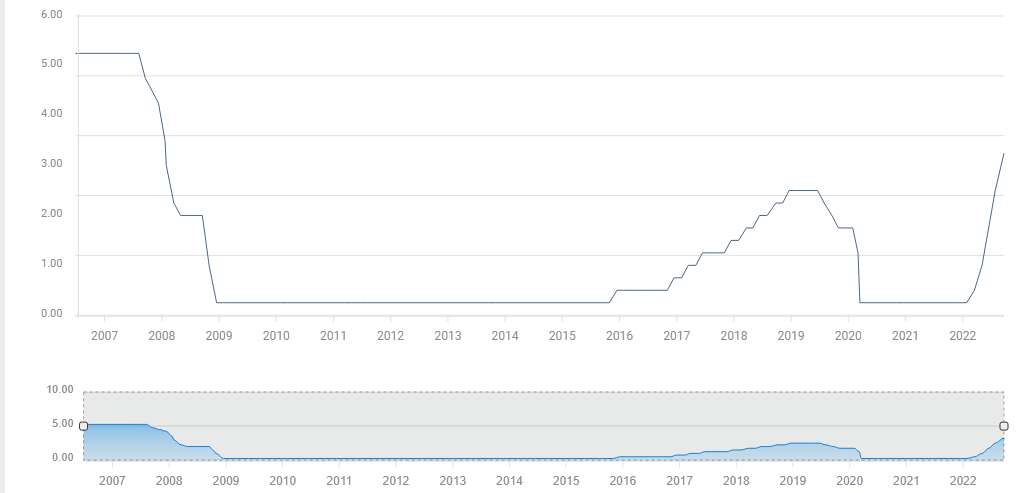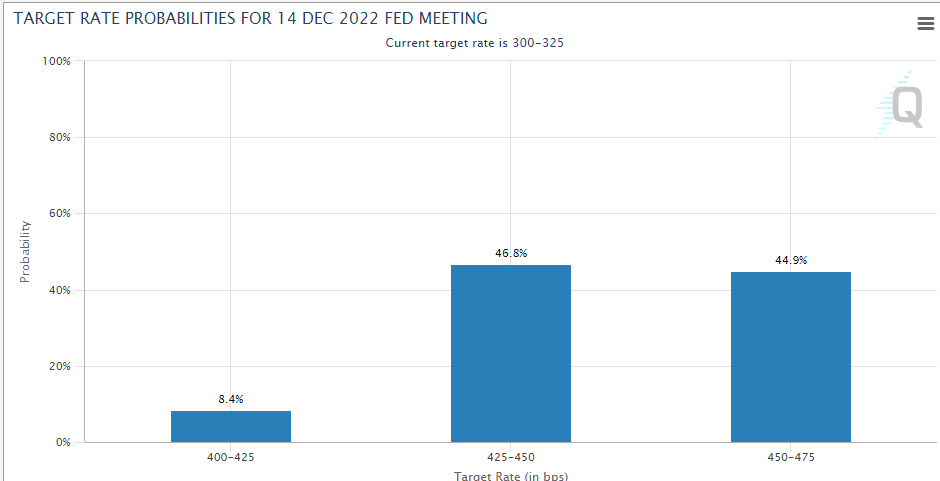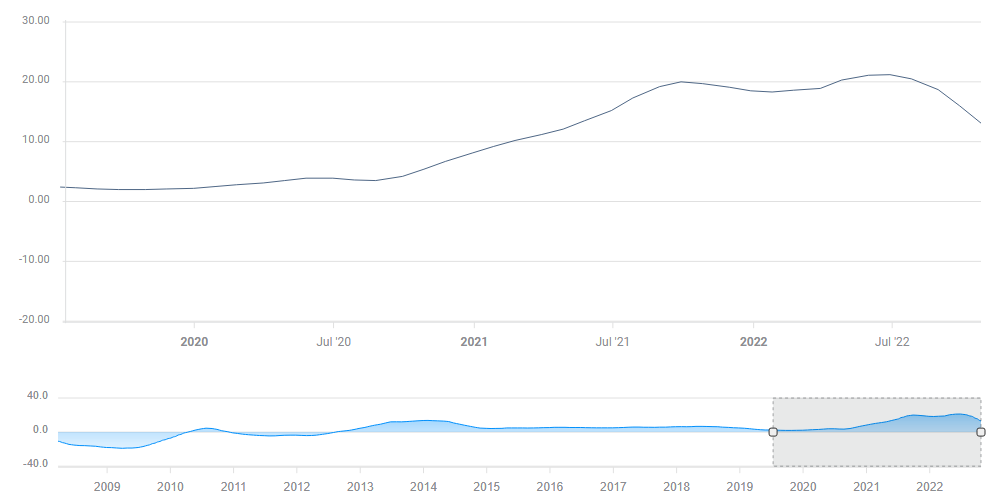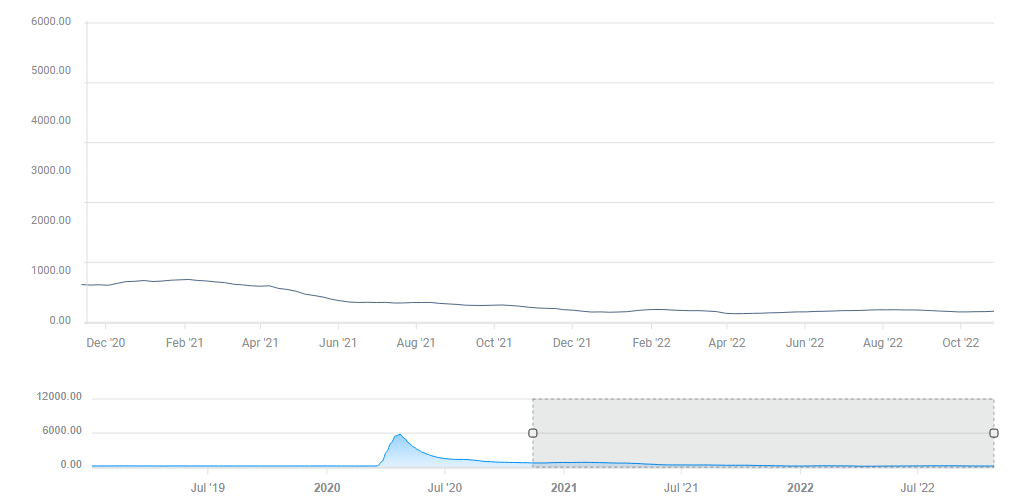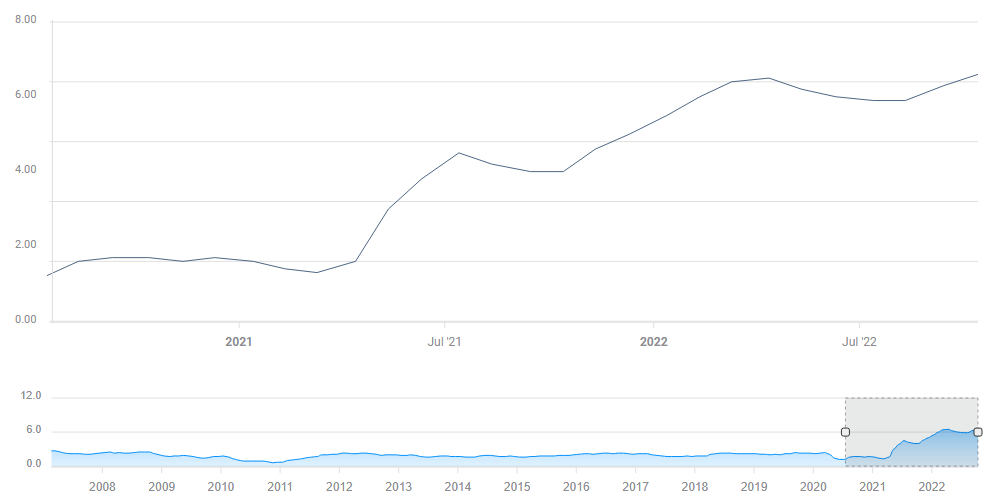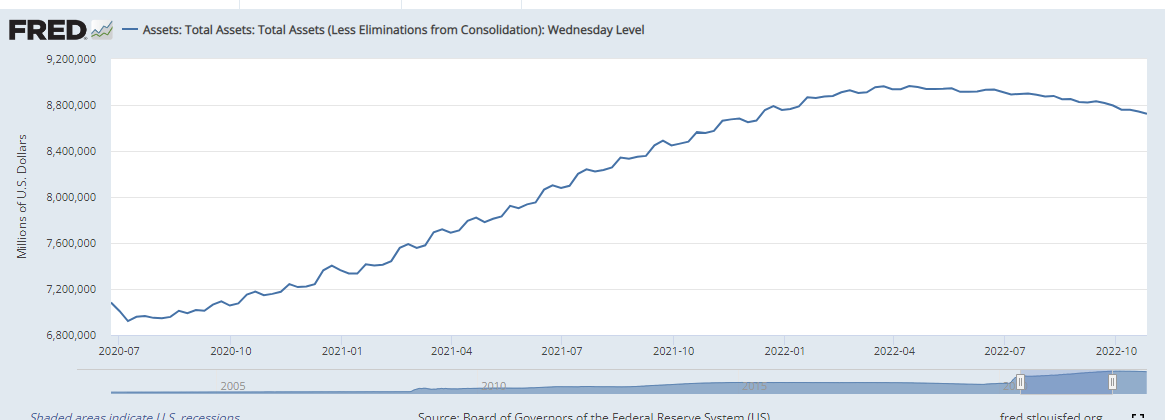- The Federal Reserve is set to raise rates by 75 bps for the fourth consecutive time.
- A slowdown in housing and a dovish Fed attack have lowered expectations for December's move.
- Rising core inflation and longing job gains leave room to counter that notion.
- Fed Chair Powell is unlikely to commit to slowing down the pace as markets expect.
- The dollar may stage a rebound in response to the Fed decision.
Is it the Federal Reserve's last hurrah? That notion of an upcoming slowdown in US rate hikes has been supporting equities and weighing on the US dollar during the bank's blackout period. I believe these great expectations have gone too far, opening the door to a greenback comeback.
First, let's clear out the obvious – the Fed is set to raise interest rates by 75 bps for the fourth time in a row. That would put the Federal Funds rate at a range of 3.75-4%, up from 3-3.25%. Fed Chair Jerome Powell and his colleagues do not like surprising markets.
Interest rates nearing pre-2008 peak:
Source: FXStreet
The big questions are: 1) what can we expect in December, 50 or 75 bps? 2) Where will the Fed stop, roughly above 5% or under it?
Previously on Fed Watch
Super strong inflation figures published on October 13 raised expectations for a steep path of rate hikes, namely a 75 bps hike in December and even a small chance of a 100 bps move now. The peak, or terminal rate, hit 5% according to bond markets.
But then came the "dove attack" of October 21. Just before members entered a period of silence ahead of their decision, they sent two clear signals of a more moderate path. First came out Nick Timiraos of the Wall Street Journal – aka "the Fed whisperer" – subtly hinting a potential slowdown in December.
Second, San Francisco Fed President Mary Daly released unscheduled remarks saying she sees the peak rate staying within the limits of the Fed's September projections, which stood at around 4.6%. These two moves, came on top of a surprisingly dovish remark from James Bullard, known as the uber-hawk. He said 2023 could be "disinflationary."
The probability of a 75 bps hike in December stands at only 44.9% at the time of writing:
Source: CME Group
The expectations game continues until the last moment. A fresh piece from Timiraos over the weekend focuses on consumers' big cushion of savings and corporations' lower debt-servicing costs. To make things clear he says:
For the Fed, a more resilient private sector means that when it comes to rate rises, the peak or “terminal” policy rate may be higher than expected.
He already hints at peak rate expectations gone too far and that may already skew the expectations.
But apart from expectations, what do the data say? Has the Fed done enough?
Tentative signs of a slowdown
The housing market feels rising interest rates more than any other. Mortgage rates for 30 years have hit 7%, pending home sales tumbled by some 10% and house prices fell by 1.3% in August, according to Case Shiller. Year over year, costs are undoubtedly undoing, reversing some a considerable chunk of the pandemic boom.
Source: FXStreet
As the Fed's policy works with a lag, perhaps it should take stock of its achievements in the housing market, expecting broader prices to fall. However, the labor market is doing well, seeing 263,000 jobs gained in September, according to the latest Nonfarm Payrolls report. The pre-pandemic average was 200,000.
The Fed is fully willing to accept pain in the jobs market as a price worth paying to see inflation down. We're not there yet. Weekly jobless claims, which provide more up-to-date data on employment, show strength.
Weekly jobless claims stood at 219,000 in the week ending October 21, within pre-pandemic levels. Even if there is a lag, the Fed should do more.
Source: FXStreet
The Fed's focus is inflation, and there was an encouraging sign coming from third quarter Gross Domestic Product figures, which pointed to a moderation in headline inflation. Nevertheless, the Fed is worried about core inflation, excluding volatile energy and food costs. And there, it is hard to find any softening.
While Core PCE – the Fed's favorite underlying inflation gauge – missed estimates with 5.1% YoY in September, the monthly figure came out at 0.5%, as expected. Moreover, Core CPI, hit 6.6% YoY last month, the highest since "Eye of the Tiger" topped charts 40 years ago.
Three reasons to go hawkish
Even if there are signs of a slowdown in the US economy, it is hard to signal that the battle against inflation is at "the beginning of the end." I expect the Fed and its Chair Jerome Powell to provide a hawkish message for three reasons.
First, high core inflation shows it is too soon to change the tone. While Fed officials may share different takes on the current state, the most important comments come from the person at the top – and after setting rates, the impactful timing. It is too soon to send consumers a calming message.
Source: FXStreet
Secondly, the Fed announces its decision just six days before the mid-term elections, with inflation topping the list of concerns for voters. It would be politically unwise of Powell to provide even the smallest signal of easing off at this juncture. He needs a poor jobs report to be able to send a more dovish message to the public.
Third, the market has already lowered expectations more than enough. Bond yields have dropped and stocks have bounced. Markets tend to go too far, and I suspect that is the reason for Timiraos' weekend article.
What to watch out for
At November's meeting, the Fed does not release new forecasts, emphasizing other things, mostly Powell's tone. If he expresses worries about the housing sector, it would be dovish, but as argued above, there is a higher likelihood of a more combative tone on inflation, which would be hawkish.
Powell is set to clarify that the Fed is data dependent and makes its decisions on a meeting-by-meeting basis, without even hinting of any potential outcome in December. The mere uncertainty could be enough to scare stocks and boost the safe-haven dollar.
He is also likely to downplay the importance of the Fed's forecasts, saying they could change. That would be a hint that the terminal rate could exceed 5%.
A surprise dissent in the vote for the expected 75 bps hike could also trigger a small knee-jerk reaction. As such a move has been well-telegraphed, the chances are slim.
One thing that could steal the show would be comments about the Fed's balance sheet. The bank is withdrawing $95 billion out of markets every month, in a process known as "Quantitative Tightening."
Source: Federal Reserve
Will worries about future liquidity issues lead the Fed to consider slowing it down?
If Powell says it is under discussion, it will send a dovish message, while insisting it is off the agenda would send a hawkish one. Markets and the Fed are focused on interest rates, but without clarity on the topic, only "data dependency," any commentary on the balance sheet could grab the spotlight.
Final thoughts
A 75 bps hike is fully priced in, and what matters is hints about what's next. Despite signs of a slowdown, it is probably too soon to signal a slowdown, contrary to other central banks. There is a greater chance the pivot will have to wait.
I want to stress that the Fed decision is a multi-faceted event, including the rate decision, the press conference and several waves of reactions by analysts and markets. A straightforward reaction like the dollar surge in response to inflation reports is unlikely. Price action is set to be two-sided and choppy, so trade with care.
Information on these pages contains forward-looking statements that involve risks and uncertainties. Markets and instruments profiled on this page are for informational purposes only and should not in any way come across as a recommendation to buy or sell in these assets. You should do your own thorough research before making any investment decisions. FXStreet does not in any way guarantee that this information is free from mistakes, errors, or material misstatements. It also does not guarantee that this information is of a timely nature. Investing in Open Markets involves a great deal of risk, including the loss of all or a portion of your investment, as well as emotional distress. All risks, losses and costs associated with investing, including total loss of principal, are your responsibility. The views and opinions expressed in this article are those of the authors and do not necessarily reflect the official policy or position of FXStreet nor its advertisers. The author will not be held responsible for information that is found at the end of links posted on this page.
If not otherwise explicitly mentioned in the body of the article, at the time of writing, the author has no position in any stock mentioned in this article and no business relationship with any company mentioned. The author has not received compensation for writing this article, other than from FXStreet.
FXStreet and the author do not provide personalized recommendations. The author makes no representations as to the accuracy, completeness, or suitability of this information. FXStreet and the author will not be liable for any errors, omissions or any losses, injuries or damages arising from this information and its display or use. Errors and omissions excepted.
The author and FXStreet are not registered investment advisors and nothing in this article is intended to be investment advice.
Recommended Content
Editors’ Picks

AUD/USD touches two-week high near 0.6350 after RBA meeting minutes
AUD/USD attracts buyers for the fifth straight day on Tuesday and climbs to a nearly two-week low near 0.6350 following the release of RBA minutes, which indicated that the May meeting would be an opportune time to reconsider reacting to potential risks. This, along with a positive risk tone, acts as a tailwind for the Aussie.

USD/JPY trades with positive bias above 143.00; upside potential seems limited
USD/JPY gains some positive traction on Tuesday and now seems to have snapped a three day losing streak to a multi-month low touched last week. The upbeat market mood undermines the safe-haven JPY and lends support amid a modest USD uptick.

Gold looks north amid US tariffs uncertainty
Gold price is bouncing back toward the record highs of $3,246 set on Monday as buyers fight back control despite a sense of calm across the financial markets early Tuesday.

Dogecoin, Shiba Inu and Fartcoin price prediction if Bitcoin crosses $100K this week
The meme coin market fell sharply on Monday, shedding 4.8% in market capitalization to settle at $49.25 billion. The sell-off coincided with increased volatility across broader crypto markets while investors rotated funds into Bitcoin briefly tested the $85,000.

Is a recession looming?
Wall Street skyrockets after Trump announces tariff delay. But gains remain limited as Trade War with China continues. Recession odds have eased, but investors remain fearful. The worst may not be over, deeper market wounds still possible.

The Best brokers to trade EUR/USD
SPONSORED Discover the top brokers for trading EUR/USD in 2025. Our list features brokers with competitive spreads, fast execution, and powerful platforms. Whether you're a beginner or an expert, find the right partner to navigate the dynamic Forex market.
